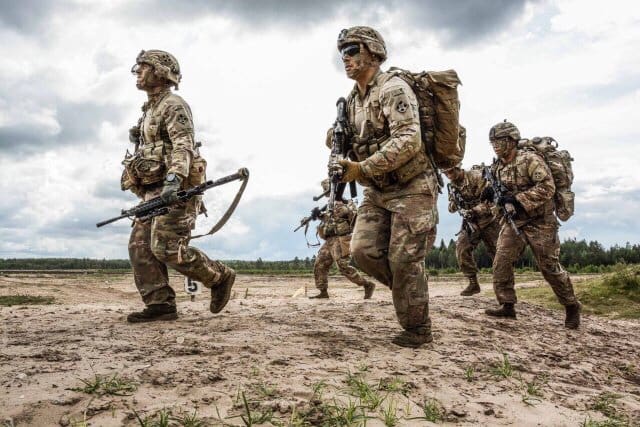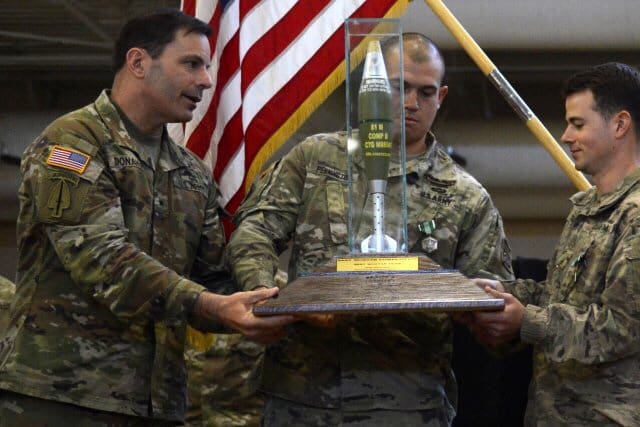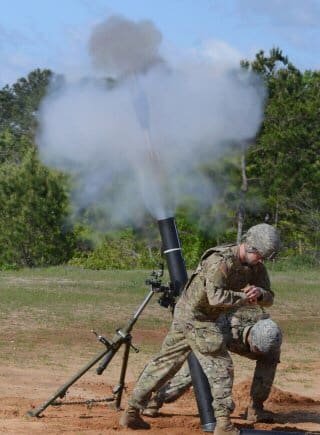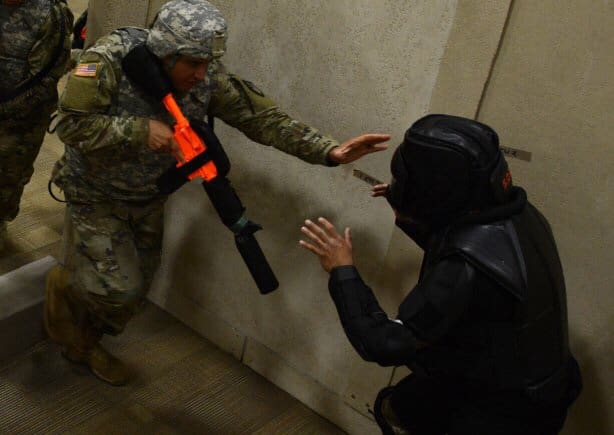FORT BENNING, Ga. — The U.S. is being challenged by a number of near-peer adversaries and, to a certain extent, terrorist organizations, said Brig. Gen. Christopher T. Donahue, Infantry School Commandant, Maneuver Center of Excellence.

Riflemen with 4th Infantry Division at Rukla Training Area, Lithuania, Aug. 24, 2017. T (Photo Credit: Photo courtesy of Lithuanian Land Forces)
“We still have the capability to defeat them all but we are at a point where we have to improve the mental and physical toughness of the infantry and ensure we’re incorporating new technologies and capabilities to ensure we remain the decisive force for the military,” he added.

Brig. Gen. Christopher T. Donahue, Infantry School Commandant, Maneuver Center of Excellence, congratulates Soldiers of the 82nd Airborne Division, who won the Best Mortar Competition during Infantry Week, April 2018 at Fort Benning, Ga. (Photo Credit: David Vergun)
Donahue spoke after attending the April 16 awards ceremony for the inaugural Best Mortar Competition. The competition was part of the April 13-20 Infantry Week here.
The general addressed several initiatives that the Army is taking to ensure the infantry retains overmatch.
One of the most fundamental responsibilities the Army has is ensuring that the right people are being selected for the Infantry Branch, he said, describing the infantry as “the 100,000 who close with the enemy.”
The Army is doing that through reform of its talent management system, he said. “We want intelligent, physically fit people who are capable of enduring hardships against a near peer.”
At higher echelon, the Office of the Secretary of Defense is also examining the attributes of a successful infantryman with its Close Combat Lethality Task Force, he added.
Once these people are recruited into the Infantry Branch, it’s important that they master infantry basics right off the bat, he said. “You can’t do anything without mastering the basics. You have to be very good at that.”

Soldiers compete in Best Mortar Competition during Infantry Week, April 2018 at Fort Benning, Ga. (Photo Credit: David Vergun)
In July, the Army will run a pilot to extend the Infantry One-Station Unit Training out to 21 weeks, he said, explaining that OSUT is the equivalent of Basic Combat Training and Advanced Individual Training.
Lengthening OSUT “will help ensure we’re producing the right person that can walk into a unit, ready to fight, win and survive,” he said.
In another initiative, the Army will be transitioning to a new marksman qualification test, he said. Soldiers will still be given 40 rounds, but instead of just shooting prone and from a foxhole, they will shoot prone, prone unsupported, kneeling and then standing — all within six minutes. “It will reflect what we think you’ll be doing in combat.”

Soldiers compete in the Combatives Tournament during Infantry Week, April 2018 at Fort Benning, Ga. (Photo Credit: David Vergun)
Soldiers will also be trained to fight in austere environments where communications is degraded or denied, he said, terming it a “multi-domain environment” that includes space, cyber, urban and even subterranean battle.
Donahue noted that when he was a lieutenant going through infantry training, Soldiers were taught how to continue the fight despite severed communications with headquarters. “We’ve got away from that, but we’re going back to doing that.”
What he didn’t learn as a lieutenant, he said, was how to deal with social media that the enemy will use to gain an advantage. That too is being incorporated into the schoolhouse.
To fight and win also means equipping Soldiers with the right technology and capability, he said. Cross-functional teams will be going after that in the new Futures Command.
For instance, virtual reality will enable Soldiers to get a lot more training in than they normally would with live-training only. Virtual training environments allow commanders to run Soldiers through many more repetitions, at no extra cost, before going to validate in a live environment.
Col. Townley Hedrick, deputy commandant for the Infantry School, said that the Army is developing a functional fitness test that will better prepare Soldiers for the rigors of combat.
Hedrick spoke after attending the Combatives Tournament awards ceremony, another Infantry Week event, held concurrently with the Best Mortar and Best Ranger competitions.
While vigorous and repetitive training is important, “when you compete at anything, it makes people up their game to the highest level,” he said. “You can train and train and train, but it’s actually competition that takes you to that final level of precision and perfection.”
Hedrick predicted that there will be more competitive events coming throughout the Army similar to those featured here during Infantry Week.
By David Vergun, Army News Service
(Follow David Vergun on Twitter: @vergunARNEWS)


I had to doublecheck the date on this article. The “new” M16/M4 qual has already been in use for years.
There’s a really new one that’s got a lot of panties twisted.
Doesn’t sound all that great to be honest. With all the emphasis on overmatch, toughness, mastering basics and near-peer you would think they would add:
1) A Known Distance (KD) range beyond 300m that would challenge soldiers on precision shooting and shot placement
2) Moving target range since, bad guys generally try to avoid being shot
Glad we got out of the foxhole, but if we are still in a flat range mentality and still shooing pop up Ivans at less than 300m, and if we still need just over 50% hits to “pass” (i.e. master basics) then what does this “change” actually accomplish?
Our ranges for rifle and machinegun would almost make you think we were training for another war like WWI, or the final phases of the Korean War, wouldn’t they?
You want to fix marksmanship, you need to make the evaluations of it match what the troops need to do in combat. We’re not fighting from fixed positions in linear battlefields, so why do our qualification standards make believe that is how we fight?
Games and gamesmanship are fine things, for training. You just need to make damn sure that the games you are setting up for everyone to play are accurately replicating what you’re doing on the battlefield. Don’t keep things current and accurate to what the troops will encounter…? You’re not doing it right.
Aligning the sights, holding the rifle, and hitting the target are only a part of what goes into a soldier being effective in combat–They also need to be able to spot the enemy, positively identify them, and do so while maintaining as much cover and concealment for themselves as possible. It’s kinda nuts that we only evaluate about a third of the skills we really need the troops to have for qualification, in order for them to be successful and survive on the battlefield.
While I agree with most of the comment, I do see the current and future/non-COIN conventional force fight being a whole lot more linear than we’d like: enemy precision CAS, arty and mortars, not to mention well-trained infantry, SOF, armor and ISR assets, will have folks back in the foxhole, especially if they’re hard-wired to COIN, Peace Support Ops, and the language/culture/media-centric command attitudes, etc. that we’ve become accustomed to. You yank the FOB out of the equation and we’re talking a set piece battlefield with forces extremely limited in mobility due primarily to inadequate support. I’d imagine the GO has been to enough UNCLASS and beyond briefings to have it hard-wired that the peer (near-peer is a bit of a foolish term…if they have a full spectrum military, satellites and extant/developing ICBMs, etc., let’s call that a peer, especially if we’re envisioning a conventional infantry vs infantry scenario) fight is going to be interesting. I wouldn’t worry much: the top level at least seems to realize we need some serious evolution across the board…and that is why we largely pussy-foot around these days when it comes to “peers”. Fixing Army and Marine infantry training is going to take a whole lot more than marksmanship, and i realize that’s not the point of the article, but it’s a component. [thanks SSD for keeping up the info flow]
I’m not sure we’re talking about the same things, when you and I say “linear battlefield”. I think you may be thinking more “high intensity”, while what I’m thinking of is the “fixed lines and battle areas” aspect of it all.
I don’t think the linear battlefield, a la WWI, is ever coming back. It was dead on the Eastern Front in WWII, and the Soviets put paid to it with all their “instructives” they gave the world during the Cold War. The only people who didn’t figure it all out? Us.
I think we need to face reality, and finally deal with the fact that there are no “secure rear areas”, even back here in the continental US. I remain convinced that we’re going to see strikes on places like McDill and Nellis, probably out in the civilian communities where our drone operators and other key personnel are living. If the enemy hasn’t already identified a bunch of those folks, and cased them for a decapitation strike, I’d be flippin’ amazed. The battlefield is wherever our troops are, and the likely time for them to be struck is whenever they’re most vulnerable. Our enemies would be nuts to take us on, fully prepared, in the field with the full range and panoply of our weapons available. So, they’ll hit us where we’re not prepared, and when we’re most vulnerable. This is the same strategy that the Soviets pioneered against the Nazis in WWII, and the one they’ve been honing continuously ever since. There are no rear areas, except those that exist solely in the minds of our leadership.
And, sad to say, I think those leaders are going to learn some hard lessons on this issue, and the rest of us are going to suffer for their lack of foresight. We need to harden targets across the board, whether it’s the 507th Maintenance Company-equivalents out in the forces, or where we’re putting our drone operators to sleep at night…
It’d be nice if they addressed some of the issues that we’ve already identified that are making all the young company-grade officers terminate their careers early.
Things like eliminating the zero-defects command culture, and doing something about our inability to delegate real power down to the junior leaders would help with that. Not to mention, cutting back on all the BS “mandatory training” that’s grown up like some kind of cancerous melanoma around things.
Hard to take a General Officer serious when he talks about qualifying from a foxhole, that’s something we have not done during qual in well over a decade. Shows how out of touch the top is with what is going on in the ranks.
Read his bio. You’re right, he may very well be out of touch with what the Army is doing.
But, to his defense, if you reread the passage, he didn’t necessarily say that.
I know they are trying to change a lot of things down at benning and how we do it. Hopefully this General will make it a course of action in the Army. Why is the Army so hesitant to change is beyond my yrs of service. My unit just got our M4’s rebuilt and its a ok change but I really wish they would jump on board with some of the things SOCCOM and USASOC are doing with rifle. The URG-I is a great move forward. It would be great to issue those to your combat arms units minus the Vortex because that could wait.
So those two little superscript marks at the beginning and ending of sentences? Those are called quotation marks, and indicate words and sentences that are quoted from a subject speaking. Note that the bit about qualifying from a foxhole isn’t surrounded by quotation marks, and thus may very well be the author’s words, and not BG Donahue’s. But sure, don’t take a guy that’s held multiple Ranger leadership positions and has commanded at every level of a premier Army SMU seriously because of how you probably misread one sentence in a full article.
Since when have we qualified in rifle marksmanship using a foxhole? Is that something new in this pilot program, or something thats infantry only?
When I was in the infantry in Europe and at Ft. Benning the foxhole was the way we did rifle qualifications during the 1980’s with the M16A1. It changed at Ft. Benning with moving targets in 1986 and 1987 with the introduction of the M16A2 rifle. They would just send you out to zero the M16A2 rifle and put you on the new electronic moving target range without any familiarization or practice. It was interesting. I went from expert to sharpshooter with the rifle that range was fun. Soviet targets moving from different angles at close ranges with stationary targets at 200m to 300m.
You have to remember how we trained in Europe during the Cold War of the 1980’s when we were outnumbered by Soviet block and USSR. It was mostly retrograde operations making use of predetermined battle positions for each element of a division sector of combat. In the Fulda Gap in West Germany, down at the company level retrograde operations focused on foxhole position with anti-armor (Dragon and LAWS) and armored defilade positions as the best protective cover with the approaching Soviet block and USSR armor and troops. We were there to slow them down by leaping frogging backwards to new positions after position until the Europeans and United States could mobilize troops state side for a counter offensive. Just different tactics for a different mission and time period than is used today.
We have focused on desert and desert urban warfare over the last 15 years that we have lost some of combat experience in mid temperate climates of Europe. Takes time to retrain for different mission mindsets, but knowledge is also lost.
Rifle qual really ought to be done at three separate levels: Lowest being the individual marksmanship skills, the one we classically have trained for. Second level ought to be “Can PFC Snuffy move and shoot dynamically and be effective…?”, with a troop required to move down a constantly changing shoot lane that replicates what they might experience in combat, and not have it be the same for any iteration except in that a set number of targets present themselves during their movement. Third level of qualification ought to be “Can PFC Snuffy work as part of a team, applying fires at the command of his team/squad/platoon leader, and can that leader direct his fires effectively?”.
And, the qual standards for that fire team, squad, and platoon leader? Damn sure ought to include how well they can “fight” their element, spotting targets and directing fires.
Yeah, setting up training like that would be challenging and expensive, but with a proper amount of the right equipment, I think I could build you a range package which could be set up just about anywhere, and then used. Nothing says that the entire qual package has to be fired with live ammo; you could do the shoot-and-move with a decent subset of the MILES gear and appropriate sensors on the targets. As well, build in a set of video cameras to enable the folks running these lanes to record what the shooters do for AAR of individual technique and group techniques.
Huge part of being effective in combat has to do with things like picking out your hasty firing positions and stuff that isn’t quite marksmanship-related, but should be trained right along side it. Maintaining situational awareness, spotting targets, identifying them, and all the rest ought to be a part of qual training, not just the raw “Can you hit the target?” stuff. You can have guys with really great range skills who can shoot the ass out of a fly at 600m, but who can’t really do a good job at spotting enemy movement at that range, or who do a horrible job picking out their hasty firing positions when they come under fire.
We need to train the whole package of skills, and evaluate for that in qualification. One has to remember that the troops train to what the commander is looking for, and if the commander is not looking for a realistic picture of their abilities, then they’re not going to train realistically, either. I’m strongly of the opinion that one of the key reasons we did as badly as we did with our small arms pursuits after WWII was that there was a strong thread of “gamesmanship” going on within the Army’s small arms training community. Our “games”, like the National Matches at Camp Perry, did not reflect what we needed to be doing in combat, and as such, the desire to be more effective at the “game” than at combat in real life led to things like the M14 being chosen over a more effective true intermediate weapon like the Brit EM-2. We had to wait until reality slapped us in the face during Vietnam, and then discover that our model and game were not quite true to reality, and that’s how we wound up throwing the M16 family into the deep end of the pool without a huge amount of forethought or preparation. It’s a damn miracle that it’s worked out as well as it has, but my strong belief is that we need to do a better job of actually modeling what we need to do in combat for both our qualification standards and our games like the National Matches. A lot of the National Match stuff is great, but not all the specialized skills we build to compete there are necessarily effective or particularly useful on the modern battlefield.
The article doesn’t tell the entire story of what’s happening at Benning. Met the entire Infantry Branch office folks between the MCoE MWF Conf in January and Best Ranger Comp a number of weeks back. They’re onto something. Again, the article says very little of what they’re actually doing down there. Bottom line, we lost the ability of how to make great people and great units over the years of continuous deployment cycles where the focus was on Petreus thinking tasks and zero emphasis on individual mastery of combat tasks. Units became transient locations, just running through command teams and NCOs, with zero continuity. I hope the generating force can create some mastery, hold people accountable for their performance. It seems the units can’t seem to focus on their people to do so.
You don’t think the loss of ability to make great people is because a risk adverse and careerist officer and NCO corps who placate every social justice policy pushed on them, lie about unit readiness, overemphasize wasteful and useless check-the-block “mandatory training” as part of a rigid training schedule designed by micromanaging senior commanders, diluting combat training through risk aversion to the point it has little training value, with an institutional mindset ensuring anyone with integrity, individuality, or independence are told to go to Selection or get out?
You know… You might just want to check into therapy, or something, because you’re basically saying the same things that got me in trouble ten years ago, before I retired. One of my bosses told me that if I wasn’t retiring, they’d have been recommending me for treatment, essentially because I was always telling them things they didn’t want to hear.
The Army was coming out of the post-Vietnam coma when I first enlisted. We spent the 1980s fixing everything we could, produced a decent combat-ready force, and then starting immediately after Desert Storm, we lost the damn bubble. It was like “Well, we won that one, now we can chill…”. And, we did–Training exercises went from being a solid third of every training quarter out in the maneuver units to being afterthoughts. There were a lot of bases here in the US where they chose to emphasize “quality-of-life” and “family time” over training value–Most clearly with III Corps, where it became nearly impossible to keep your unit in the field over a weekend. Translated into reality, that meant that your training time went from thirty days at a whack to Tuesday-Wednesday-Thursday, with Monday for getting to the field, and Friday for securing everything and going back into garrison “for the families”.
Somewhere along the line, we forgot Rommel’s dictum that the best welfare for the troops was quality training; the end product of these policies we were seeing out at the NTC during the period where all these things came together was disturbing, to say the least. A lot of what went on at the NTC during the 1990s went from being the classical “National Testing Center” thing we vets of the 1980s knew to being the “National Hand-holding Center” during the later years of the 1990s. It wasn’t a change for the better, either… The NTC was meant to be a graduate-level experience where you proved your mettle against the best challenge we could replicate, not the half-ass “training opportunity” it turned into there at the ass-end of the ’90s. Of course, that wasn’t entirely the Army’s fault–The budgets we had for training funds were raped to pay for all the idiocies in foreign policy that the Clintons got us into. Some of the units we got in while I was there hadn’t had more than a few precious days of training, before coming down to the NTC, and the first time they saw adequate fuel or ammo for training was with us, too.
We’re going to need another renaissance in military training, akin to the one after Vietnam, but I’ll be damned if I know where the impetus and motivation is going to come from, or where they’re going to find another set of leaders like we had back then. I suspect that DePuy, Abrams, and the rest of those giants would have never made it through the winnowing that Clinton and Obama conducted during their tenures.
The most disturbing thing I noticed during the ’90s was that every single junior officer or fellow enlisted guy that I wanted to work for and around…? The vast majority chose to end their careers early, after the Wall came down. Or, out of frustration that nobody was taking things seriously, anymore. My absolute favorite “I’d-walk-through-fire-to-work-for-him-again” company commander took a look at things during the late ’90s, and chose to go off along the Corps of Engineers public works track, rather than hang around and be a battalion commander. He felt badly enough about doing that that he sent all of us an apology letter, because there were that many of his former subordinates who were anxiously waiting to find out what battalion he was going to be taking, so we could finagle our ways there to work for him. Thing was, he did the math, and at that point, he figured he’d better make the choice for his family, and future employment. Nobody saw 9/11 coming.
You’re definitely on the right track.